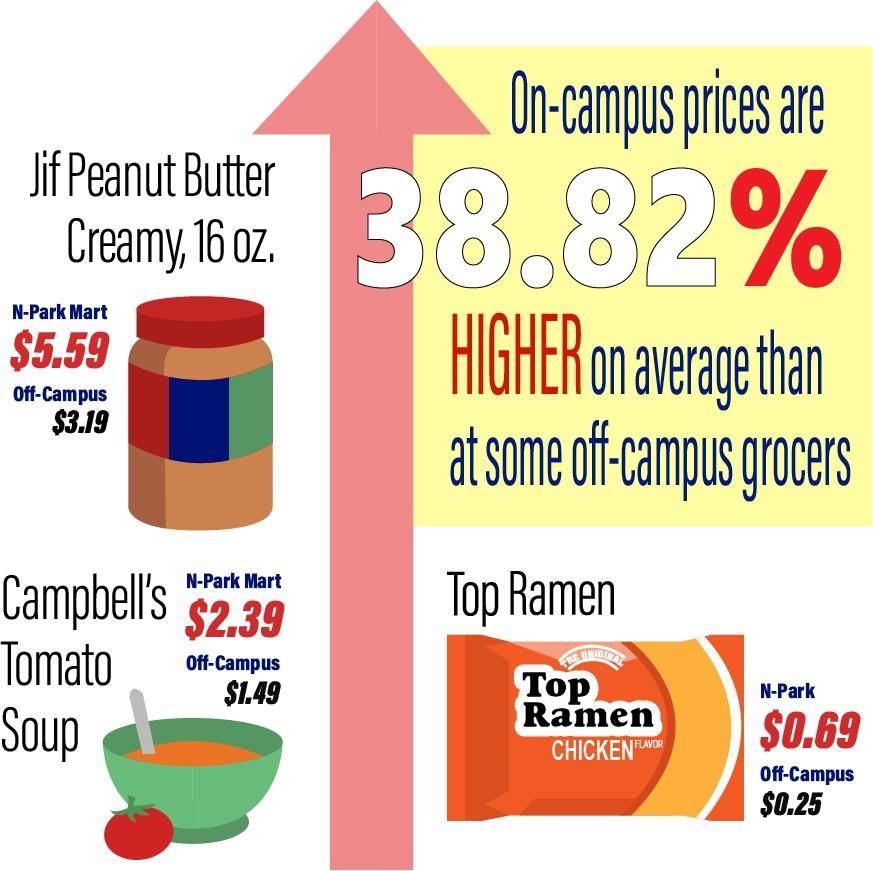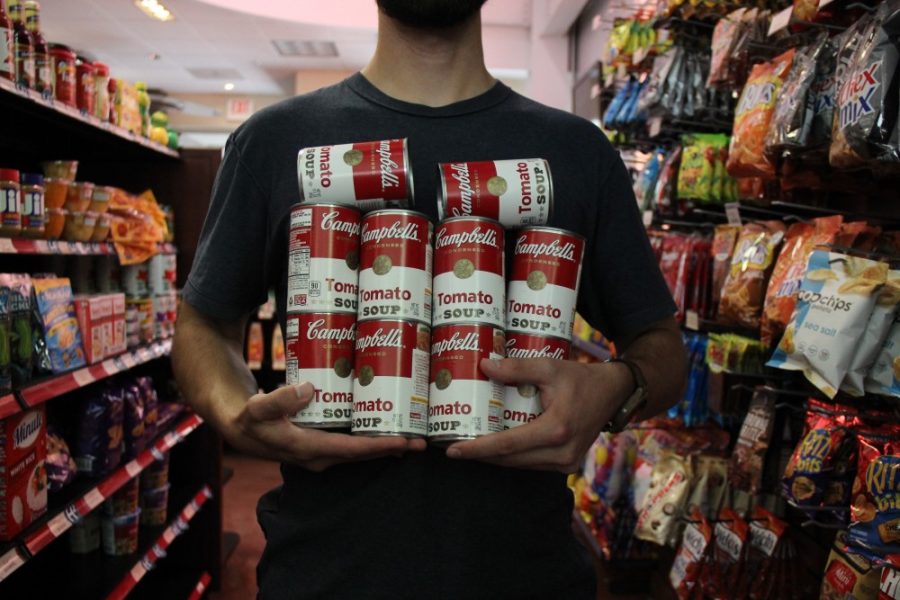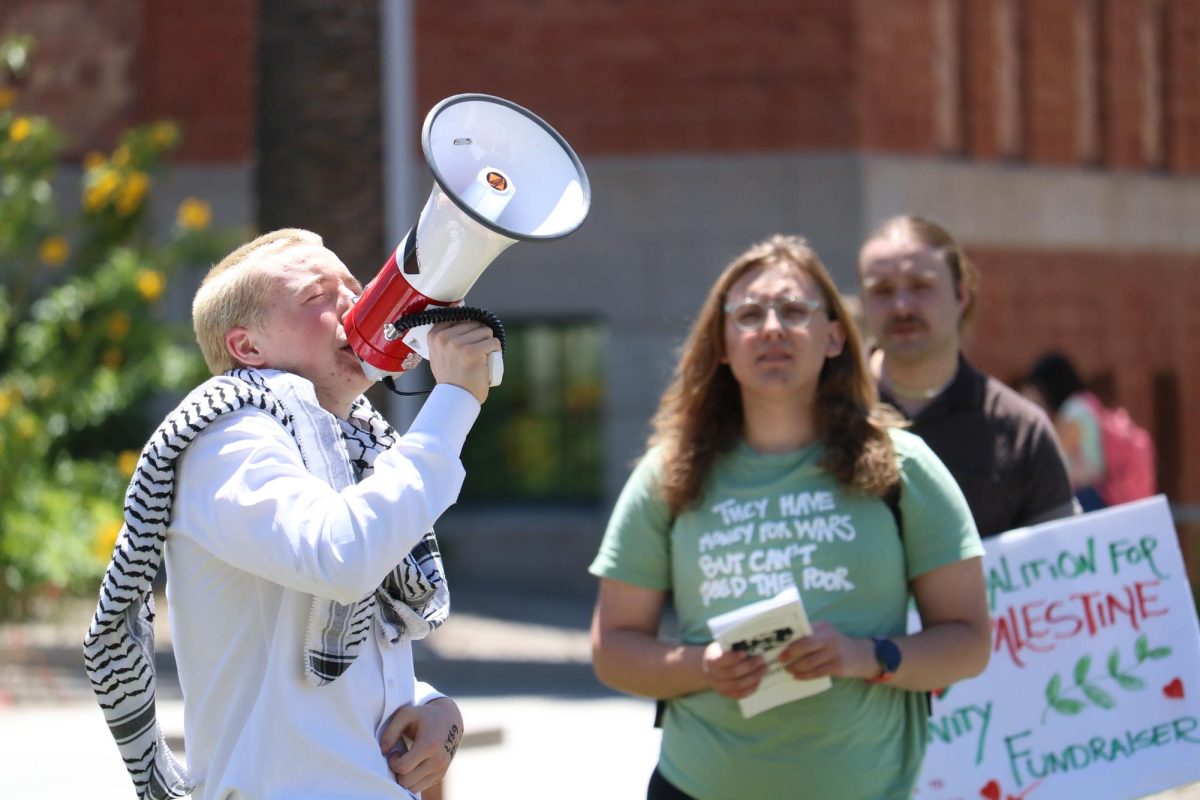Students living on campus at the University of Arizona may find shopping for their own groceries hard. Prices of food items, such as Oreos, peanut butter, granola and Top Ramen at on-campus markets were priced higher than when they were found at grocery stores such as Safeway and Fry’s.
The prices of 50 items were analyzed and compared between the three on-campus markets, Park Avenue Market, U-Mart and Highland Market and the grocery stores Safeway and Fry’s.
Of the 50 food items that were compared, there was an average of 29.80%* increase on prices for products sold at the campus markets** than the same items sold at Fry’s and an average of 38.82% increase of prices compared to Safeway.
RELATED: Gender pay discrepancies among deans and faculty at the University of Arizona
A dozen eggs at the Highland Market costs $3.59, while at Fry’s, a dozen eggs costs $1.99. Folger’s coffee at the Park Avenue Market costs $8.79 but the same product at Safeway costs $5.99.
Todd Millay, the senior director of the Arizona Student Unions, said in an email response that the reason the prices at the UA are higher than a grocery store chain such as Safeway is because they do not have the volume to buy inventory at the cheaper prices of chain grocery stores.
He also said the Student Unions’ large facilities come with many other costs that contribute to the higher prices at the UA markets.
“Our electric bill, IT needs, facilities costs, etc. are much higher than a grocery store,” Millay said. “In order to cover those costs, our prices in certain products, particularly prepackaged goods, will naturally be higher. For non pre-packaged foods, we are commonly at fair market prices.”
“The reason why there may be price discrepancies between PSU, Highland market or U-Mart is still debatable,” Millay said. “Currently, those operations finances run independently from one another, so our managers have flexibility to adjust pricing to some extent to ensure they have a sustainable operation.”
Michaela Davenport, the student director of Campus Pantry, said the higher prices found at the UA market does affect students, especially those living on campus.
Campus Pantry is a student-run organization that offers free groceries to supplement the needs of students, faculty and staff on campus.
RELATED: Campus-run organizations help provide ‘food assistance’ to UA community

“I think it definitely affects students, especially students, maybe, who have difficulty obtaining transportation or something like that, and sort of depend on these close-to-campus resources,” Davenport said.
Spencer Ciammitti, a sophomore studying molecular and cellular biology who lives at Árbol De La Vida, said, “I get most of my groceries off campus just due to the price gouging. I don’t want to overpay, and saving money is a major goal of mine in college.”
Davenport said the abnormally high prices potentially have an effect on many of the students on campus who already struggle with food insecurity.
The 2016 Campus Climate Booklet said “52% of undergraduate and 29% of graduate respondents indicated that they often or always ate unhealthy or nutritiously unbalanced meals because healthier options were too expensive or inaccessible,” and according to a survey created by the Hope Center for College, Community, and Justice, 41% of four-year university students experienced food insecurity.
The USDA defines food insecurity as “a lack of consistent access to enough food for an active, healthy life.” However, Davenport said that for college students, food insecurity can manifest in many different ways.
“It’s not necessarily about a constant state of hunger, right?” she said. “It’s not like all the time you’re starving or anything like that, but it could be at the end of each month before you get your last paycheck for the month and you’ve paid all your rent and your utilities and stuff, you don’t quite have enough money to make it stretch or you have to really make meals last.”
UA is considered to be located in a “food desert,” Davenport explained. Food deserts are areas that are not accessible to fresh groceries and therefore add to the overall food insecurity of those living there.
“If you think about where is Fry’s and where is Safeway, not close enough to walk, not really anyway,” Davenport said.
A lot of industries on campus, not just food, seem to have higher prices than those same industries off campus, Davenport added. She said that some housing units are charging $1,000 per person per month.
“So, I think businesses and stuff close to the university think that being close to the university, ‘Oh we can charge these prices,’ but I don’t think for a lot of low-income college students who attend this university, I don’t think that is fair or equitable,” Davenport said.
Lucas Quilter, assistant administrative director of SafeRide and a junior studying political science, said that SafeRide, an ASUA-sponsored student-run carpool-ride share program, is meant to be a solution to the lack of accessible and safe transportation on campus.
Quilter said that SafeRide’s goal is to ensure that students on campus know they have someone to call when they don’t feel safe, or even if they just don’t want to spend money on other ride share programs such as Uber or Lyft.
“That’s where SafeRide comes in,” Quilter said. “We are free and unlimited. You can use us however many times you want to go within our two-mile boundary to get to restaurants, shopping centers, El Con, Walmart, Target [and] any of that kind of stuff. We help people who don’t want to pay $5, $10, $15 in Uber charges to get in and around the hot spots of Tucson.”
Grocery stores are included in the two-mile boundary that SafeRide drives to, according to Quilter.
“If you are trying to pay $6 for a carton of eggs, we can do that for you” Quilter said. “Or if you are trying to pay $2 for a carton of eggs we can also bring you there.”
Davenport said that while she would like to know why these prices at the UA markets are higher than prices at other grocery stores, the Student Union has worked a lot with Campus Pantry to supply food to students in need.
She said they donated the space that Campus Pantry currently uses in the union and provide produce from the rooftop gardens, among other things.
RELATED: Student Unions’ plantED Culinary Workshop series returns
While these higher prices found at campus markets should be talked about and lowering them could help students, lowering them will not fix food insecurity on campus, Davenport said.
“Food insecurity does not exist because the high prices charged at the Student Union,” Davenport said. “Food insecurity exists because college is expensive, because rent is outrageous, because healthcare is ridiculous, because all these other factors. So, I think this is a symptom that helps perpetuate food insecurity for sure, I don’t think it’s helpful that we charge high prices here, but also I don’t think that’s necessarily the main thing we should be tackling.”
Davenport said she believes the true solution to food insecurity lies in institutional change.
For more information on Campus Pantry, which offers free groceries to students, visit their website at campuspantry.arizona.edu. SafeRide offers students free rides to nearby groceries stores. For more information, visit their website at azsaferide.wixsite.com/saferide or call 520-621-SAFE (7233).
*CORRECTION (9/10/19, 10:14 p.m.): The original analysis of the percentage difference between groceries at Fry’s, Safeway and on-campus stores were incorrect. The percentage difference should state, “Of the 50 food items that were compared, the average prices for products sold at the campus markets cost 68.71% more than the same items sold at Fry’s and an average of 38.82% more than prices compared to Safeway.”
**prices for campus markets were taken from the product with the lowest price of all of the markets or from the price of one product if it was only sold at one market.
Follow Jake Toole on Twitter









